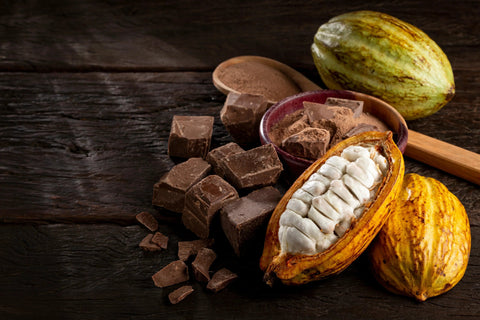You are here because you like chocolate, right? Like, really love it, can't resist it, especially a good piece of chocolate? Don't feel bad. You're not the only one. But have you ever thought about how this wonderful treat came to be? I did and decided to go on a journey to find out the secret behind chocolate. Trust me, it's a fascinating story.
Choco-historical origins
The story indeed begins in the lush Amazon jungle, where the Theobroma cacao tree thrives. This tree's fruits contain the cacao beans, the primary ingredient for making chocolate.
Imagine a fruit unlike any other: not your typical apple or berry. The cocoa pod, the source of all things chocolate, is a fascinating sight to behold.

Think of a football, but slightly more elongated and bumpy. These pods range from 6 to 12 inches in length and about 3 to 5 inches in width. They grow directly from the trunk and branches of the cacao tree, not from a stem like most fruits.
As the pod ripens, its vibrant green hue transforms into a dazzling array of colors. You might see hints of yellow, orange, red, purple, or even maroon, depending on the variety and stage of maturity. The outer shell can be smooth, leathery, or even warty, adding to its unique appearance.
Crack open the pod and you'll discover a surprising contrast. While the outside is tough and fibrous, the inside holds a sweet surprise: a creamy white, juicy pulp that surrounds the prized treasure – the cocoa beans. Each pod can hold anywhere from 20 to 60 of these oval-shaped beans.
The Sacred Seed of Civilizations
Archaeologists believe that the Mayo-Chinchipe culture in today's Ecuador were the first to cultivate this tree around 5,300 years ago. But it was the Olmecs from Mesoamerica (what we now call Mexico and Central America) who discovered the true power of chocolate. They made a strong, frothy beverage from fermented beans, which they used in rituals and healing.
They fermented, roasted, and ground the beans into a paste, which they mixed with water to create a frothy drink. This beverage was used in sacred rituals and as medicine, showing their deep respect for this unique bean.
The Mayans, who succeeded the Olmecs, took this reverence even further. They dubbed chocolate "xocolatl," translating to "bitter water" and worshipped it as the "food of the gods." Their version of the chocolate drink was similar to the Olmecs', but they often added spices and cornmeal for extra flavour.
Then came the Aztecs, who saw great value in cacao beans. They used them not only for their bitter-sweet drink but also as a currency for trade and tax payments. Their chocolate drink was frothier than the Mayan's, often infused with vanilla and other spices. They believed it was an aphrodisiac, a gift from the god Quetzalcoatl.
A sweet affair: Cacao meets Europe
The Spanish conquest of the Aztec Empire in the 16th century marked a turning point in the history of chocolate. Hernán Cortés, captivated by the Aztecs' prized drink, brought cocoa beans back to Spain. The Spaniards sweetened the bitter brew with cane sugar, transforming it into a luxury drink for the European nobility. As production methods improved over time, chocolate gradually became available to the masses.
Today, chocolate is a universally adored treat, enjoyed in countless forms worldwide. From rich truffles and silky milk chocolate bars to gourmet artisanal creations, it has come a long way from its humble origins. But every bite indeed carries with it a rich history steeped in tradition, innovation, and cultural significance.
So the next time you savour some chocolate, remember this epic journey it has taken from the Amazon to your taste buds. It's a narrative filled with tradition, transformation, and a whole lot of deliciousness. Now, if you'll excuse me, there's a dark chocolate calling my name. Enjoy your own chocolate journey and I invite you to share it with me.



